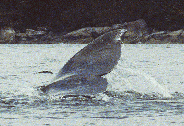
Photoidentification
Individual marine mammals can be identified by the pigmentation on their bodies. We use black and white photographs of the flanks (sides) and flukes (tails) to "mark" the animals so that they can be counted. These photographs are collected into a catalogue so that later pictures can be matched and the same whale only counted once. The technique was pioneered in the early 1970's by people such as Mike Bigg (killer whales), Roger Paine (right whales), Jim Darling (grey whales) and Steve Katona (humpback whales). Today the technique is applied to just about every kind of cetacean and even a few pinnipeds (seals and sea-lions).
 Return to the
Return to the